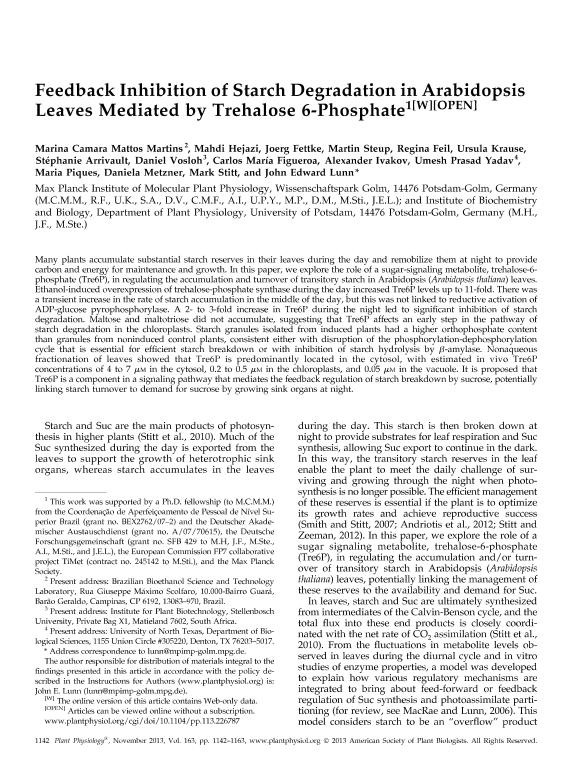Mostrar el registro sencillo del ítem
dc.contributor.author
Mattos Martins, Marina Camara
dc.contributor.author
Hejazi, Mahdi
dc.contributor.author
Fettke, Joerg
dc.contributor.author
Steup, Martin
dc.contributor.author
Feil, Regina
dc.contributor.author
Krause, Ursula
dc.contributor.author
Arrivault, Stéphanie
dc.contributor.author
Vosloh, Daniel
dc.contributor.author
Figueroa, Carlos Maria

dc.contributor.author
Ivakov, Alexander
dc.contributor.author
Yadav, Umesh Prasad
dc.contributor.author
Piques, Maria
dc.contributor.author
Metzner, Daniela
dc.contributor.author
Stitt, Mark
dc.contributor.author
Lunn, John Edward
dc.date.available
2017-11-03T14:43:56Z
dc.date.issued
2013-11
dc.identifier.citation
Mattos Martins, Marina Camara; Hejazi, Mahdi; Fettke, Joerg; Steup, Martin; Feil, Regina; et al.; Feedback inhibition of starch degradation in Arabidopsis leaves mediated by trehalose 6-phosphate; American Society of Plant Biologist; Plant Physiology; 163; 3; 11-2013; 1142-1163
dc.identifier.issn
0032-0889
dc.identifier.uri
http://hdl.handle.net/11336/27531
dc.description.abstract
Many plants accumulate substantial starch reserves in their leaves during the day and remobilize them at night to provide carbon and energy for maintenance and growth. In this paper, we explore the role of a sugar-signaling metabolite, trehalose-6-phosphate (Tre6P), in regulating the accumulation and turnover of transitory starch in Arabidopsis (<em>Arabidopsis thaliana</em>) leaves. Ethanol-induced overexpression of trehalose-phosphate synthase during the day increased Tre6P levels up to 11-fold. There was a transient increase in the rate of starch accumulation in the middle of the day, but this was not linked to reductive activation of ADP-glucose pyrophosphorylase. A 2- to 3-fold increase in Tre6P during the night led to significant inhibition of starch degradation. Maltose and maltotriose did not accumulate, suggesting that Tre6P affects an early step in the pathway of starch degradation in the chloroplasts. Starch granules isolated from induced plants had a higher orthophosphate content than granules from noninduced control plants, consistent either with disruption of the phosphorylation-dephosphorylation cycle that is essential for efficient starch breakdown or with inhibition of starch hydrolysis by beta-amylase. Nonaqueous fractionation of leaves showed that Tre6P is predominantly located in the cytosol, with estimated in vivo Tre6P concentrations of 4 to 7 µM in the cytosol, 0.2 to 0.5 µM in the chloroplasts, and 0.05 µM in the vacuole. It is proposed that Tre6P is a component in a signaling pathway that mediates the feedback regulation of starch breakdown by sucrose, potentially linking starch turnover to demand for sucrose by growing sink organs at night.
dc.format
application/pdf
dc.language.iso
eng
dc.publisher
American Society of Plant Biologist

dc.rights
info:eu-repo/semantics/openAccess
dc.rights.uri
https://creativecommons.org/licenses/by-nc-sa/2.5/ar/
dc.subject
Trehalose-6-Phosphate
dc.subject.classification
Bioquímica y Biología Molecular

dc.subject.classification
Ciencias Biológicas

dc.subject.classification
CIENCIAS NATURALES Y EXACTAS

dc.title
Feedback inhibition of starch degradation in Arabidopsis leaves mediated by trehalose 6-phosphate
dc.type
info:eu-repo/semantics/article
dc.type
info:ar-repo/semantics/artículo
dc.type
info:eu-repo/semantics/publishedVersion
dc.date.updated
2017-08-24T18:46:57Z
dc.journal.volume
163
dc.journal.number
3
dc.journal.pagination
1142-1163
dc.journal.pais
Estados Unidos

dc.description.fil
Fil: Mattos Martins, Marina Camara. Max Planck Institute of Molecular Plant Physiology; Alemania
dc.description.fil
Fil: Hejazi, Mahdi. Max Planck Institute of Molecular Plant Physiology; Alemania
dc.description.fil
Fil: Fettke, Joerg. Max Planck Institute of Molecular Plant Physiology; Alemania
dc.description.fil
Fil: Steup, Martin. Max Planck Institute of Molecular Plant Physiology; Alemania
dc.description.fil
Fil: Feil, Regina. Max Planck Institute of Molecular Plant Physiology; Alemania
dc.description.fil
Fil: Krause, Ursula. Max Planck Institute of Molecular Plant Physiology; Alemania
dc.description.fil
Fil: Arrivault, Stéphanie. Max Planck Institute of Molecular Plant Physiology; Alemania
dc.description.fil
Fil: Vosloh, Daniel. Max Planck Institute of Molecular Plant Physiology; Alemania
dc.description.fil
Fil: Figueroa, Carlos Maria. Consejo Nacional de Investigaciones Científicas y Técnicas. Centro Científico Tecnológico Conicet - Santa Fe. Instituto de Agrobiotecnología del Litoral. Universidad Nacional del Litoral. Instituto de Agrobiotecnología del Litoral; Argentina. Max Planck Institute of Molecular Plant Physiology; Alemania
dc.description.fil
Fil: Ivakov, Alexander. Max Planck Institute of Molecular Plant Physiology; Alemania
dc.description.fil
Fil: Yadav, Umesh Prasad. Max Planck Institute of Molecular Plant Physiology; Alemania
dc.description.fil
Fil: Piques, Maria. Max Planck Institute of Molecular Plant Physiology; Alemania
dc.description.fil
Fil: Metzner, Daniela. Max Planck Institute of Molecular Plant Physiology; Alemania
dc.description.fil
Fil: Stitt, Mark. Max Planck Institute of Molecular Plant Physiology; Alemania
dc.description.fil
Fil: Lunn, John Edward. Max Planck Institute of Molecular Plant Physiology; Alemania
dc.journal.title
Plant Physiology

dc.relation.alternativeid
info:eu-repo/semantics/altIdentifier/url/http://www.plantphysiol.org/content/163/3/1142
dc.relation.alternativeid
info:eu-repo/semantics/altIdentifier/doi/http://dx.doi.org/10.1104%2Fpp.113.226787
Archivos asociados
